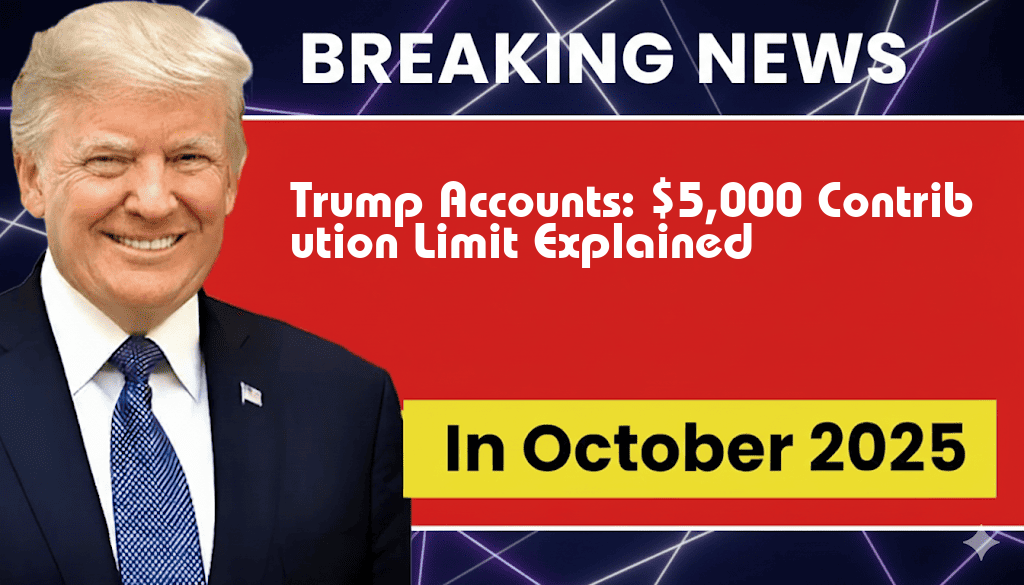The recent implementation of a $5,000 annual contribution limit for Trump accounts has sparked discussions about its implications for political financing and campaign strategies. This new regulation, aimed at enhancing transparency in political donations, directly affects how supporters can financially back the former president’s initiatives and events. As the political landscape evolves, understanding the nuances of this contribution cap is essential for both donors and recipients. This article delves into the specifics of the $5,000 limit, explores its potential impact on Trump’s fundraising efforts, and examines the broader implications for political campaigns across the nation.
What Is the $5,000 Contribution Limit?
The $5,000 annual contribution limit applies to individual donations made to Trump’s political accounts, including his campaign and affiliated political action committees (PACs). This regulation follows a series of reforms aimed at preventing excessive financial influence in politics and ensuring a more level playing field among candidates.
Background on Political Contribution Limits
Political contribution limits have been a contentious issue in the United States, with various laws enacted over the years to regulate the flow of money in politics. The Federal Election Commission (FEC) sets guidelines that determine how much individuals can donate to candidates, parties, and PACs. Historically, these limits are designed to combat corruption and promote fair competition.
Implications for Trump’s Fundraising Strategy
With the new $5,000 cap, Trump and his team must rethink their fundraising strategies. This limit could significantly affect the volume of contributions he receives, as large donors traditionally play a crucial role in campaign financing.
- Reduced Large Donations: The cap restricts high-net-worth individuals from making significant contributions that could bolster Trump’s campaign. This change might lead to a reliance on smaller donations, which could alter the dynamics of his fundraising events.
- Increased Engagement: The limit may encourage Trump to engage more frequently with a broader base of supporters, fostering a sense of community among smaller donors.
- Shift in Campaign Messaging: Trump’s messaging may also shift, focusing less on attracting big donors and more on grassroots support.
Challenges Ahead
While the $5,000 contribution limit seeks to level the playing field, it presents several challenges for Trump and his campaign apparatus.
Adapting to New Regulations
The campaign will need to adapt to the regulatory environment and ensure compliance with all FEC guidelines. This includes meticulous record-keeping and reporting of contributions, which can be labor-intensive and requires robust organizational capabilities.
Potential Impact on PACs
Political Action Committees (PACs) associated with Trump may also feel the pinch from the contribution limit. Many PACs rely on large donations to fund their activities, and the cap could hinder their ability to raise substantial sums. As a result, these organizations might need to pivot their strategies to attract a wider array of smaller donors.
Broader Implications for Political Campaigns
The introduction of the $5,000 limit is not just a pivotal moment for Trump’s campaign; it also reflects a growing trend in U.S. politics aimed at reforming campaign finance.
- Encouraging Transparency: This move aligns with ongoing efforts to increase transparency in political donations, allowing voters to better understand the sources of campaign funding.
- Influencing Other Campaigns: Other candidates may follow suit, implementing similar contribution limits to attract supporters who prefer transparency in political financing.
- Possible Legal Challenges: The new limit could face legal scrutiny, as some factions argue that it infringes on free speech rights as defined by the Supreme Court in Citizens United v. FEC.
Conclusion
The $5,000 annual contribution limit is a significant development in the realm of political financing, particularly for Trump accounts. As the former president adapts to these new restrictions, the ripple effects may be felt across the political spectrum, influencing how candidates engage with their supporters and fund their campaigns. Understanding these changes is essential for stakeholders in the political process, ensuring that they are prepared for the evolving landscape of campaign financing.
| Type of Contribution | Individual Limit | Cycle Limit |
|---|---|---|
| Individual Contributions to Candidates | $2,900 | $5,800 |
| Contributions to PACs | $5,000 | $15,000 |
Frequently Asked Questions
What is the annual $5,000 contribution limit for Trump accounts?
The annual $5,000 contribution limit refers to the maximum amount that individuals can contribute to their Trump accounts in a given year, which is designed to regulate fundraising and ensure compliance with financial guidelines.
How does the $5,000 contribution limit affect campaign fundraising?
The $5,000 contribution limit can significantly impact campaign fundraising by restricting the total amount of money that can be raised from individual donors, potentially affecting overall campaign strategies and outreach efforts.
Are there any exceptions to the $5,000 contribution limit?
Currently, there are no widely recognized exceptions to the $5,000 contribution limit, although specific circumstances may arise that could alter how contributions are processed or reported.
What happens if a donor exceeds the $5,000 contribution limit?
If a donor exceeds the $5,000 contribution limit, the excess amount may be returned to the donor or reported as a violation, which could lead to penalties for both the campaign and the donor involved.
How can individuals stay informed about changes to the $5,000 contribution limit?
Individuals can stay informed about changes to the $5,000 contribution limit by subscribing to updates from the Federal Election Commission (FEC) or following reputable news sources that cover political finance issues.

Leave a Reply